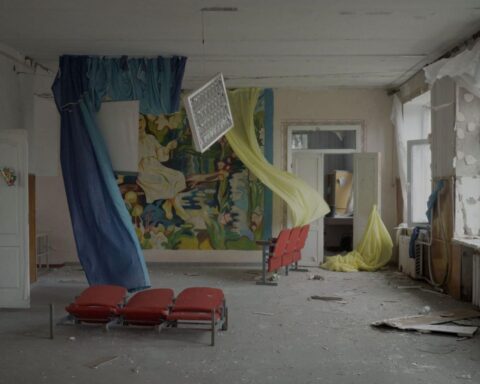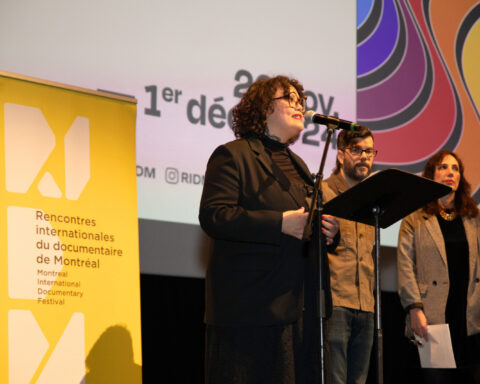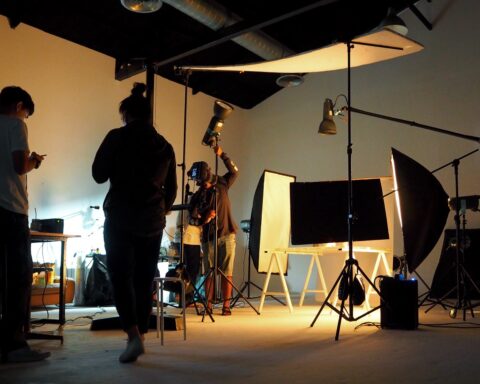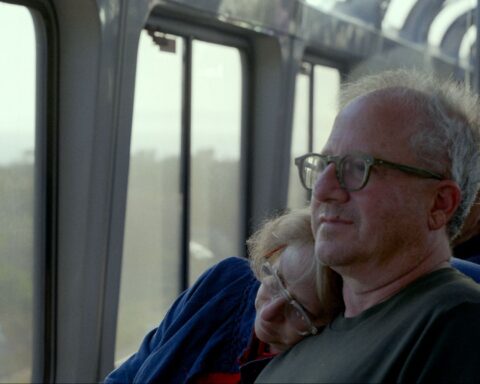RIDM (Rencontres internationales du documentaire de Montréal) is a documentary film festival by name, but a term used in the festival’s publicity materials describes perhaps more accurately its distinct approach to programming: le cinéma du réel —cinema of the real, or, as it is somewhat disappointingly translated, “reality-based cinema.” RIDM’s programming, which reaches far beyond what is generally considered “documentary film,” shows a sincere dedication to films that push the boundaries of the cinematic medium insofar as it is considered as a means of showing the truth of things—a dedication to continuing to probe the relation between cinema and the real.
It is the liberal approach to deciding what to include in a doc festival that puts RIDM in touch with documentary’s fascinating, dark undercurrent (or countercurrent), which has existed since cinema’s inception with the first films of the Lumière brothers. At least since Démolition d’un mur (a film shot by Louis Lumière in 1895, cinema’s first year), wherein a concrete wall shatters after being knocked over, only to recompose and right itself when the film reel is reversed, a distinct way of thinking and making documentary has coexisted alongside its conventional ethos. It’s one less preoccupied with faithfully representing reality on film and more concerned with the ways in which cinema can transform our way of viewing reality—as the sudden reversal of the film reel certainly did for anyone who saw Démolition d’un mur in 1895.
In addition to some very exciting outside-the-box films, RIDM, in its 18th edition this year, showcased a number of films laudable for their honest and steadfast adherence to the traditional creed of documentary cinema—to show their subjects as they are, without embellishment and with as little artifice as technical considerations and the need to be comprehensive allow. Jean-Gabriel Périot’s new film Une jeunesse allemande relies entirely on archival footage, with no added voiceover, in showing the rise and fall of the left-wing militant Baader-Meinhof Group in ‘60s and ‘70s West Germany. The purity of means employed in making the film allows for it to be relatively void of any rhetorical stance, and it is all the more engaging for that. Like Andrei Ujică in his 2010 all-archival film, The Autobiography of Nicolae Ceausescu, which tracks the Romanian dictator from his rise through his long reign (1965-89) to his spectacular fall from power, Périot does us the service of mining an immense archive and compiling the footage that will have the greatest resonance for audiences with the advantage of historical hindsight.
Structurally comparable to Périot’s Une jeunesse allemande is Dominic Gagnon’s controversial found-footage film Of the North, composed entirely of material culled from YouTube and other internet sources (including a couple of clips from pornographic video-sharing websites) shot in the Arctic, and predominately in Nunavut. Gagnon, who has never visited the Arctic himself, drew fierce criticism from accomplished Inuit artist Tanya Tagaq, whose music was used in the film without permission, for its representation of Indigenous northern people. While Tagaq’s criticisms have been widely reported in the media, the film has received a much smaller audience and deserves at least some benefit of the doubt from those who haven’t seen it. Neither the film nor the filmmaker claim any authority to represent the reality of life in the north, nor is its second-hand representation (as a document of self-representation) necessarily an unkind one—in other words, taken as a whole, it does not come off as an exploitation film. Scenes of Inuit girls practicing throat singing, boys doing video-editing magic tricks, community dances and a close encounter with a polar bear accompany those that are presumably found objectionable—numerous scenes of drunkenness, a long shot of a woman with face out of frame masturbating, a trucker in Alaska exhibiting a young, naked Inuit (“Eskimo”) sex worker before the camera. These latter scenes are difficult to watch, even for someone with no experience of life in the north or the collective traumas of the Inuit. But no particular statement can be read from them. The film displays a total absence of rhetoric—it is more of a simple compilation than an essay or a narrative. It’s not an artistically laudable film by any means, but it’s difficult to take a close look at it and condemn it unilaterally. It can at least be said that Gagnon’s film raises a number of questions about representation in documentary film—an easy way out for a film critic, but true nonetheless.
For a film that can be condemned on grounds of racism with much less hesitation, see French filmmaker Nicolas Boone’s 2014 short film Hillbrow, also screened at the festival. For the film, Boone travelled to Hillbrow, a once-trendy but now impoverished suburb of Johannesburg, collected stories (apparently all of which involved crime and violence perpetrated by black people) and re-enacted them using locals as actors. A commenter on the film’s IMDb page who identifies himself as Nigel Branken of Hillbrow, Johannesburg reports on a screening of the film in his neighbourhood at which many of the actors were present: “It was evident that many of the actors (who had been co-opted from Hillbrow) were angry about the way they had been portrayed. It seemed evident that they felt used by the directors. We are not sure what actions should be taken by our community to fully express our disgust and concern at the filmmakers desire to show this movie around the world.” Hard to argue with that, and harder still to argue that the film is a document of much other than the continued (hopefully clueless) dehumanization of black South Africans.
Meanwhile, veteran Chilean filmmaker and Third Cinema pioneer Patricio Guzmán’s The Pearl Button ambitiously weaves two moments in the history of his country around the central thread of water. What begins (intentionally or not—I couldn’t tell) like an overblown commercial nature documentary becomes a solemn, but methodical investigation of the affinity between colonialism and fascism in the Chilean context. Between the near-extermination of the seafaring Kawésqar indigenous people of the country’s south and the murder of political prisoners during the Pinochet regime—thrown into the ocean dead or alive after having their bodies bound to iron rails—Guzmán draws undeniable parallels between the attempts by European colonists to wipe the land clean of indigenous peoples and their cultures and the attempts by the Pinochet regime to silence the victims of its brutality. With no document of the acts themselves, other than the testimonies of those who carried them out and the rusted rails that remain at the bottom of the ocean, Guzmán, with the assistance of a pilot who flew one of the helicopters from which the bodies were dumped, re-enacts the entire process, from the procedure of securing the bodies through to dropping them from the aircraft into the depths of the ocean. Guzmán likewise works to undo the silencing of the Kawésqar by interviewing all of the remaining native speakers, having them tell stories from their youth, in their native tongue, of the last time in history when their traditional seafaring life was still practiced. The film is ethically and artistically commendable in its attempt to represent what is unjustifiably unrepresented or unrepresentable.
From here, we go down the rabbit hole that RIDM graciously provides us with—a generous selection of films that break the rules of conventional documentary in the greater service of a truth which, it turns out, is not so easily captured through the usual means. From Harvard University’s Sensory Ethnography Lab (profiled by POV in 2013, the same year a retrospective of films produced by the lab happened at RIDM) comes Ah humanity!, a new film by anthropologists Lucien Castaing-Taylor, Ernst Karel and Véréna Paravel. Combining footage from Fukushima shot on an iPhone camera through a telescope with sound (assembled by Karel) recorded on location as well as in seismic labs, plus audio clips from Japanese films including the famous kaiju film Gojira, Shohei Imamura’s Black Rain (about the victims of the Nagasaki fallout) and Noriaki Tsuchimoto’s Minamata: The Victims and Their World (about the Minamata mercury poisoning disease), the film is a dense package of sensory material, difficult to handle if you’re not expecting it. The harsh sound and the shaky, zoomed footage place the viewer simultaneously inside and outside the disaster zone, which but for the way it is presented could be a normal, fully-functioning city. The disaster in the film is therefore a simulated one, like the earthquakes used in the soundtrack, but the city itself is nonetheless viewed from a distance that is not comfortable but distinctly uneasy. Given the subject matter of the film, one cannot help but recall Alain Resnais’ Hiroshima mon amour and its insistence upon the unrepresentability of “Hiroshima,” a problem which the makers of Ah humanity! approach in an entirely original way, not attempting to solve it but rather transforming it into a problem of distance, which the film’s website poses as follows: “Does using a telescope or a camera, aiming at objects and diminishing distance, really bring us closer and make the experience more intimate and more human? When does getting closer yield a more adequate representation of reality? Is distance, optical and experiential, a reason for human lack of agency and seemingly carefree destruction of Nature? What kind of distance engenders human caring and feeling one with the reality observed?” These, at least, are the questions that the filmmakers want us to ask—they don’t necessarily pose themselves irresistibly in the film. What is irresistible is the distinct sensation of anxiety produced by the collision of abrasive sound with disorienting images of uncertain proximity. As the film’s website also states, “_Ah humanity!_ is an artwork one would prefer not to describe.”
Paired with Ah humanity! for its second screening, Khalik Allah’s film Field Niggas (along with its director) seemed to be somewhat of an audience favourite, packing the room full for both of its screenings and each time garnering huge applause. A 59-minute film, which feels about half that length, it is composed of slow-motion footage with non-sync location sound, shot on the corner of 125th Street and Lexington Avenue in Harlem. Field Niggas is at once a powerful social documentary about New York City’s poorest and most disadvantaged people and an impressive, sustained formal exercise. Allah, who has made several films in Harlem before and shot countless photographs (some of which were also on exhibit at RIDM) chooses to dissociate body from voice, denying his audience the ‘realistic’ experience of a verité documentary view of his subjects in favour of a chopped and screwed collage of sound and image. One doesn’t know whether the intimacy one feels with the people of 125th and Lex comes from seeing their faces in slow-mo hi-def close-up or from hearing their voices telling us about their philosophies of life, their drug use, their criminal history, their struggles raising children, or freestyling and laughing with their friends. “I’m looking at you beyond the body,” Allah says to a woman who asks him how she looks—perhaps a key to understanding what is going on in this strange space between image and sound. We’re looking at bodies, and hearing voices, but the disjuncture between the two creates a new way of understanding of what’s in front of us.
The film recreates, over and over, the experience of seeing a person in passing and forming a judgment or set of assumptions about their life, their past, their character, their habits, and then meeting that person again, by chance, in another setting, speaking to them, and realising the hubris of one’s assumptions—except both moments are happening simultaneously, through different sensory channels. Despite the close-ups, a certain distance is created, perhaps giving an answer to some of the questions asked by Ah humanity!. Field Niggas is an astoundingly effective film given its formal simplicity (not to underplay its beautiful photography)—the director’s background is in music videos, and the technique of shooting without sound is borrowed from that. The soundtrack was put together after the video had been edited, making it a kind of reversal of the music video production process. Despite its simplicity, however, it’s hard not to see it as a work of genius.
Speaking of which, Toronto-based filmmaker Isiah Medina’s first feature film, 88:88, had its Quebec premiere at RIDM, having already screened at the Toronto, Locarno and New York film festivals. Medina, 23 years old, makes films like an 80-year-old Godard, or like an 80-year-old Godard would if he were 23 and grew up poor in Winnipeg instead of rich in Switzerland. Medina is a true Godardian insofar as he, like Godard, considers cinema to be une forme qui pense —a form that thinks. 88:88, like most of Godard’s films, is full of quotations—mostly, as far as I can tell, from the philosophy of Alain Badiou—however, the thought in Medina’s film is not to be found in the books that he and his friends read out loud, but in the space between text and image and between image and image: the cut, his principal philosophical and aesthetic preoccupation. While it would be impossible to get to the core of what 88:88 is all about here (see the extended interview with Medina in Cinema Scope for some pointers), if forced, I can say that it is a beautiful film about poverty, friendship, and the experience of having nothing and is full of an intellectual exuberance (even immodesty) that is incredibly refreshing to see in a Canadian film.
We can continue to be thankful to RIDM for being a documentary festival where the avant-garde is not marginalised or ignored, but put on equal footing with films more likely to capture the public imagination. It’s a rare event where the question, “What is cinema?” is still considered relevant, and where film can still be thought of as having legitimate pretentions to philosophy—as Medina puts it via Alain Badiou, as a “friend of truth.” Considering the “resounding success” (according to a post-festival communiqué) of the festival’s 18th edition, RIDM’s rigourous approach to programming and its resistance toward populism are working out marvellously.











